Evidence and expertise drive cardiac surgery innovation at Children’s National Hospital
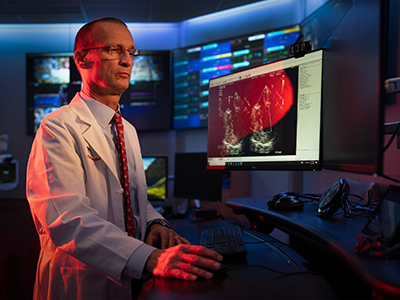
“Our goal is to do the difficult and the impossible,” says Yves d’Udekem, M.D., Ph.D.
“Our goal is to do the difficult and the impossible,” says Yves d’Udekem, M.D., Ph.D., chief of Cardiac Surgery at Children’s National Hospital.
Dr. d’Udekem and the cardiac surgeons at Children’s National apply technical skill and expertise to offer renewed hope for the highest risk children with critical congenital heart disease, including those with single ventricle anomalies like hypoplastic left heart syndrome.
“When families have nowhere else to turn, they can turn to us,” he adds.
Why it matters
The cardiac surgery team has welcomed families from across the United States and around the world who seek experts in the care of these critical heart conditions. Their experience is building an important evidence base for better surgical approaches that will improve long-term outcomes for children with many different types of congenital heart disease, but especially for single ventricle conditions.
Innovation in cardiac surgery
- Hybrid surgical strategy: Cardiac Surgeon Can Yerebakan, M.D., and Interventional Cardiology Director Joshua Kanter, M.D., are national leaders in the use of a hybrid surgical strategy for high-risk infants with single ventricle heart conditions. They can perform this procedure on babies as small as 1.1 kilograms. It allows critical time for the lungs and other organs to recover and get stronger after birth before the child undergoes more invasive procedures.
- New uses for artificial hearts: d’Udekem showed proof-of-concept for the use of an artificial heart to give a child with a single ventricle the time for their own heart to recover rather than being transplanted. In this case, the child was supported by a left-ventricle assist device (LVAD) long term. As their own heart recovered, surgeons then performed successful procedures that seemed impossible to perform before.
- Novel complex pulmonary artery reconstruction: Children’s National performs the most complex lobar and sub-lobar pulmonary artery reconstruction for children with complex pulmonary stenosis. Cardiac Surgeon Manan Desai, M.D., says the approach leverages interventional cardiac imaging and precision surgical techniques to correct stenosis in smaller lung arteries. This helps establish better right-sided pressure in the heart and likely reduces the chance of heart failure down the road.
- Pediatric-focused advanced lung care and transplant: Children’s National is poised to become one of only a few locations in the United States to offer comprehensive care for children with complex lung conditions. In 2024, Cardiac Surgeon Aybala Tongut, M.D., will begin performing pediatric lung transplants as part of the hospital’s Advanced Lung Disease Program focused on the unique needs of children.
Children’s National leads the way
“It’s time to combine firsthand expertise and long-term outcomes from decades of congenital heart surgical procedures to refine our surgical techniques,” says Dr. d’Udekem. “We need to ensure patients with congenital heart disease, especially those with single ventricle heart defects, can thrive long term.”
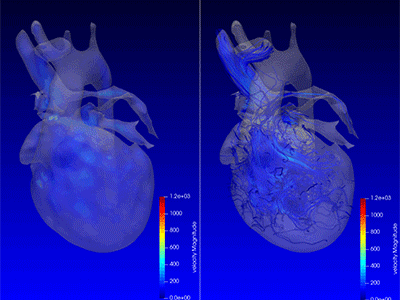
Soon, the Children’s National team plans to re-examine the effectiveness of different techniques for the Fontan procedure. They’ll compare an extracardiac approach against the older lateral tunnel procedure to determine how best to reduce long-term pressure on the heart by creating larger conduits and improving blood flow.
More education is needed to ensure valve repairs for children with congenital heart disease, including single ventricle conditions, which have a high rate of failure and require reoperation, are as successful as can be. The goal is to avoid the need for reoperation or replacement procedures. This is why Children’s National recently hosted the inaugural Valve Repair Symposium. It featured practical cases illustrated with intraoperative video, echocardiography and MR images to bring critical knowledge about pediatric heart valve repair to more people in the field.



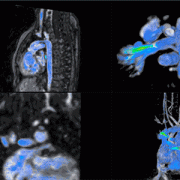

 A clinical trial testing a new drug to increase growth in children with short stature. The first ever high-intensity focused ultrasound procedure on a pediatric patient with neurofibromatosis. A low dose gene therapy vector that restores the ability of injured muscle fibers to repair. These were among the most popular articles we published on Innovation District in 2022. Read on for our full top 10 list.
A clinical trial testing a new drug to increase growth in children with short stature. The first ever high-intensity focused ultrasound procedure on a pediatric patient with neurofibromatosis. A low dose gene therapy vector that restores the ability of injured muscle fibers to repair. These were among the most popular articles we published on Innovation District in 2022. Read on for our full top 10 list.



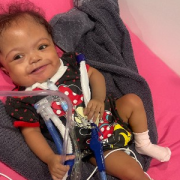
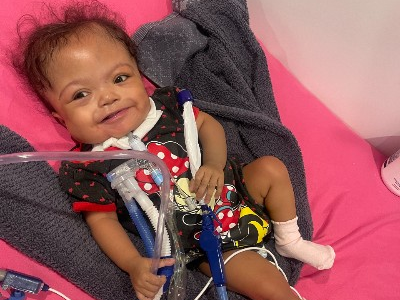 A staged, hybrid cardiac surgical strategy can give fragile infants with hypoplastic left heart syndrome (HLHS) critical time to grow and get stronger. It also gives doctors more time to understand and care for any complicating conditions before necessary open-heart surgery. Doctors at Children’s National Hospital used
A staged, hybrid cardiac surgical strategy can give fragile infants with hypoplastic left heart syndrome (HLHS) critical time to grow and get stronger. It also gives doctors more time to understand and care for any complicating conditions before necessary open-heart surgery. Doctors at Children’s National Hospital used  According to Gil Wernovsky, M.D., a cardiac intensive care doctor at Children’s National and Ashley’s Children’s National cardiologist, her birth weight was too low — she weighed 1.1 kilos or 2.4 pounds — for surgery. Her lungs also were not developed enough. She was so small, she lived in the hospital for several more weeks under the care of Dr. Lindsey. Dr. Wernovsky credits the team at Inova Children’s Hospital for providing the support Ashley needed so she could grow and develop to a place where the hybrid procedure was possible.
According to Gil Wernovsky, M.D., a cardiac intensive care doctor at Children’s National and Ashley’s Children’s National cardiologist, her birth weight was too low — she weighed 1.1 kilos or 2.4 pounds — for surgery. Her lungs also were not developed enough. She was so small, she lived in the hospital for several more weeks under the care of Dr. Lindsey. Dr. Wernovsky credits the team at Inova Children’s Hospital for providing the support Ashley needed so she could grow and develop to a place where the hybrid procedure was possible.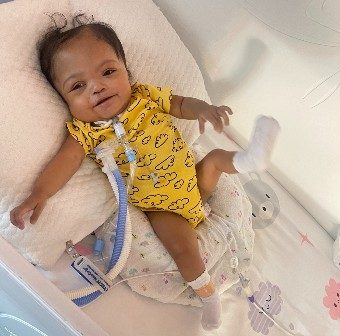 In July 2021, Ashley went home for the first time in her life. She hasn’t needed to be hospitalized since her discharge. She’s monitored jointly by Dr. Lindsey and the Children’s National single ventricle monitoring program. That program stays in touch with families virtually three times each week. Her care team keeps up with her growth and development through telehealth. Ana Mercedes shares videos and photos of Ashley as part of her routine updates to the clinical team.
In July 2021, Ashley went home for the first time in her life. She hasn’t needed to be hospitalized since her discharge. She’s monitored jointly by Dr. Lindsey and the Children’s National single ventricle monitoring program. That program stays in touch with families virtually three times each week. Her care team keeps up with her growth and development through telehealth. Ana Mercedes shares videos and photos of Ashley as part of her routine updates to the clinical team.


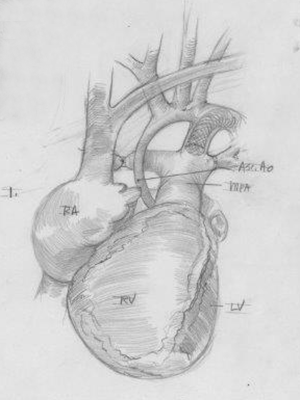

 Dr. Yerebakan comes to Children’s National from the prestigious Pediatric Heart Center in Giessen, Germany, where he was appointed as an Associate Professor of Cardiac Surgery at the Justus-Liebig-University and performed hybrid treatment of hypoplastic left heart syndrome (HLHS). He was deeply involved in mechanical circulatory support and pediatric heart transplantation in Giessen – a leading center for pediatric heart transplantation in Europe. He also served as Chief of Clinical and Experimental Research in the Department of Congenital Cardiac Surgery at Justus-Liebig-University of Giessen, where he acquired several research grants and contributed to more than 20 abstract presentations at national and international meetings and 20 papers in peer-reviewed journals. . Dr. Yerebakan has published approximately 70 scientific papers with more than 160 impact points in three different languages. He is an active reviewer for journals such as the Journal of Thoracic and Cardiovascular Surgery, European Journal of Cardiothoracic Surgery and serves as assistant editor of the Interactive Cardiovascular and Thoracic Surgery journal and Multimedia Manual Cardiothoracic Surgery journal, both of which are official journals of the European Association of Cardiothoracic Surgery. He has had a distinguished academic career and is internationally recognized for his contributions to the field of congenital cardiac surgery, particularly in the treatment of HLHS and novel surgical treatments for heart failure in the pediatric population. Prior to his tenure at Pediatric Heart Center, Dr. Yerebakan completed his fellowship at Children’s in 2011.
Dr. Yerebakan comes to Children’s National from the prestigious Pediatric Heart Center in Giessen, Germany, where he was appointed as an Associate Professor of Cardiac Surgery at the Justus-Liebig-University and performed hybrid treatment of hypoplastic left heart syndrome (HLHS). He was deeply involved in mechanical circulatory support and pediatric heart transplantation in Giessen – a leading center for pediatric heart transplantation in Europe. He also served as Chief of Clinical and Experimental Research in the Department of Congenital Cardiac Surgery at Justus-Liebig-University of Giessen, where he acquired several research grants and contributed to more than 20 abstract presentations at national and international meetings and 20 papers in peer-reviewed journals. . Dr. Yerebakan has published approximately 70 scientific papers with more than 160 impact points in three different languages. He is an active reviewer for journals such as the Journal of Thoracic and Cardiovascular Surgery, European Journal of Cardiothoracic Surgery and serves as assistant editor of the Interactive Cardiovascular and Thoracic Surgery journal and Multimedia Manual Cardiothoracic Surgery journal, both of which are official journals of the European Association of Cardiothoracic Surgery. He has had a distinguished academic career and is internationally recognized for his contributions to the field of congenital cardiac surgery, particularly in the treatment of HLHS and novel surgical treatments for heart failure in the pediatric population. Prior to his tenure at Pediatric Heart Center, Dr. Yerebakan completed his fellowship at Children’s in 2011. Dr. Ramakrishnan joined Children’s National as a fellow in 2014 after completing his fellowship in congenital cardiac surgery at two major centers in Australia. After his two-year fellowship at Children’s, he joined the faculty. Dr. Ramakrishnan has extensive experience in managing children with congenital heart disease. Apart from routine open heart procedures, he has a special expertise in extracorporeal membrane oxygenation (ECMO) procedures and patent ductus arteriosus (PDA) ligation in extremely premature babies. He also has a keen interest in studying clinical outcomes after pediatric heart surgery. His research projects have included analysis of the United Network of Organ Sharing (UNOS) and the Pediatric Health Information System® (PHIS) databases, and his research has resulted in numerous presentations at national and international meetings. Dr. Ramakrishnan is currently the principal investigator at Children’s National for the Pediatric Heart Transplant Study (PHTS) group and the study coordinator for the Congenital Heart Surgeons’ Society (CHSS) studies. He also is a member of the PHTS working group on the surveillance and diagnosis of cellular rejection, and his clinical studies have resulted in several publications in top peer-reviewed journals.
Dr. Ramakrishnan joined Children’s National as a fellow in 2014 after completing his fellowship in congenital cardiac surgery at two major centers in Australia. After his two-year fellowship at Children’s, he joined the faculty. Dr. Ramakrishnan has extensive experience in managing children with congenital heart disease. Apart from routine open heart procedures, he has a special expertise in extracorporeal membrane oxygenation (ECMO) procedures and patent ductus arteriosus (PDA) ligation in extremely premature babies. He also has a keen interest in studying clinical outcomes after pediatric heart surgery. His research projects have included analysis of the United Network of Organ Sharing (UNOS) and the Pediatric Health Information System® (PHIS) databases, and his research has resulted in numerous presentations at national and international meetings. Dr. Ramakrishnan is currently the principal investigator at Children’s National for the Pediatric Heart Transplant Study (PHTS) group and the study coordinator for the Congenital Heart Surgeons’ Society (CHSS) studies. He also is a member of the PHTS working group on the surveillance and diagnosis of cellular rejection, and his clinical studies have resulted in several publications in top peer-reviewed journals.